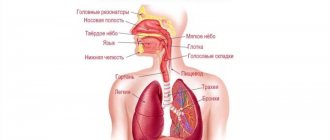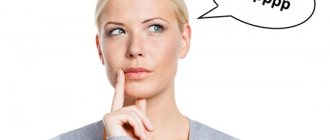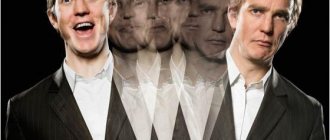Lies have long become an integral part of every person’s life. When telling lies, people can be guided by different motives: deception can be purposeful, aimed at humiliating a person, or it can be unintentional, to save relationships between people. In this article we will consider not so much the reasons for lying, but its signs. You will learn how to activate your internal “lie detector,” which will help you recognize by a person’s facial expressions and gestures whether he is lying or telling the truth.
How to recognize a lie from your interlocutor: counting a liar
The face is the mirror of the soul.
Marcus Tullius Cicero
- 1.How to recognize a lie by facial expressions? 1.1.Symmetry and lies
- 3.1.Step back
- 5.1. Features of lies in the interlocutor’s speech and facial expression
- Praise your man correctly and he will be at your feet!
- How to recognize a lie from your interlocutor: counting a liar
- When is a lie good?
- How to catch lies and insincerity in speech
- How to learn to lie professionally
Useful books on the psychology of lying
As I already said, you can perfectly determine by the face and other parts of the body whether they are lying to you. For this I recommend these books:
- Paul Ekman “Know a liar by his facial expression”, “Psychology of lying. Fool me if you can.”
- Allan Pease, Body Language.
- Evgeniy Spiritsa “Psychology of lies and deception. How to expose a liar."
- Alexander Tarasov “Recognize a liar! How to recognize deception. 12 practical tips.”
- Joe Navarro Louder Than Words. How to understand nonverbal signals.”
- Charles Ford “The Psychology of Deception. How, why and why even honest people lie.”
- Pamela Meyer “How to recognize a lie. Effective methods for detecting deception.”
For a complete list of books with descriptions, see our separate article.
Lying is a conscious choice
After a stimulus is presented, the human mind tries to determine whether the stimulus is dangerous. If a stimulus is qualified as dangerous in a specific context, a number of changes occur in the body: increased muscle tone, increased latency to answer a question, freezing of the body and/or gaze. This is the so-called “approximate fading point” (TOF). Then the person seems to “hang” and pause before answering. At this moment, he is faced with a choice: how to adapt to this situation, through the truth or through lies. After TOZ we can hear both lies and truth. In other words, TOZ is the reaction after which we need to be more attentive to the person’s further behavior and to the analysis of his reactions.
If a person has chosen a lie as a way of adapting to this situation, then the body’s first response will be a sharp increase in the body’s physiological reactions with the full mobilization of functional reserves. It is this mobilization that we will see in the form of the physiological signs of stress listed above.
However, we must understand that stress occurs not only when a person hides information. Stress can also arise when a person is uncomfortable talking about something, or he is embarrassed by the conditions in which the conversation is held, or he has had a similar negative experience in his life. There are many reasons that lead to stress. That is why we also analyze speech. If signs of ANS accompany speech that is replete with evasions and other neurolinguistic signs of deception, then with a high degree of probability we can say that the person in this situation is telling a lie.
Speech is a unique phenomenon that distinguishes us from the rest of the animal world. Aristotle's assertion that words "symbolize" our "mental experience" has been confirmed by research by anthropologists, psychologists and linguists who have shown that our written and spoken language is a reflection of the deep structure of our consciousness. From the point of view of lie detection, we are interested not so much in the content of the statement as in its structuring by the person being interviewed. Here are several linguistic patterns from the structure of the speech involved : generalizations (everyone, always, no one), justifying the intentions of the criminal, distancing from the scene of the crime and from the identity of the victim. An uninvolved person associates himself with the crime scene, helps in reasoning about what happened, describes in detail the information he has, and condemns the person involved, using harsh language in describing what happened. And that is not all. In the speech of those involved, we also encounter other speech patterns that are similar to manipulation. Separately, we can note a frequently occurring pattern - subterfuge. Varieties of evasions include speech patterns such as amnesia, communication about communication, pressure on conscience, etc. In addition, during a survey conversation, a liar is often given away by careless statements and speech leaks. Sometimes they are also called Freudian slips.
Read also: How to change geolocation on iPhone
Gestures of deception
Touching your nose during a conversation is a sign of deception
Let's figure out how you can understand from a person's actions that he is deceiving; we recognize lies by gestures.
- During a conversation, the interlocutor touches his face.
- When talking, an individual involuntarily tries to cover his mouth with his hands. In essence, he is trying to close it so that the lie does not come out.
- Touches the nose, earlobes.
- While talking to you, the individual begins to rub his eye.
- Gestures widely with hands when it is inappropriate.
- He behaves stiffly, his movements are constrained. There are practically no gestures. Perhaps he is ashamed of his deception. Or he is afraid to give himself away with any movement.
However, you need to understand that gestures alone cannot be the only criterion for identifying a liar. The fact is that a person can rub his eye, for example, because he wants to sleep or something has gotten there, or an eyelash has bent. This is not always a sign of deception.
Sight
In the courses at the Benefit studio, teachers pay great attention to the work of the eyes. With the help of facial expressions, and primarily gaze, feedback is achieved during communication. Your gestures and words may look very convincing, but if your gaze expresses a different emotion, the interlocutor will intuitively recognize a lie.
The eyes, as we know, lie first. You can tell from the eyes that a person is lying based on a number of signs.
- Pupil size.
The pupil changes size not only under the influence of light, it also reacts to the attitude towards the words of the interlocutor, more specifically, to agreement and disagreement. If a person agrees with you, his pupils will be wider; if he disagrees, his pupils will be narrower. So, in a nodding person with narrow pupils, it is not difficult to recognize a deceiver. - Visual contact.
A liar either avoids looking you in the eye or, conversely, looks you in the face much more often than the situation requires. In addition, when a person tries to make “honest eyes,” he blinks less often due to tension. - Running glance.
This is the most famous sign of lying. We can add that we instinctively do not trust a person with “shifty eyes,” even if this is his usual manner. - Reaction to the question.
A person who truly remembers something always looks away, down or up, even if it only lasts a second. The fact is that lying always requires additional memory efforts: for example, you need to remember to the smallest detail two versions of events - genuine and fictitious. The person who listened to the question and answered it, without ceasing to look into your eyes, clearly did not remember anything. Maybe because there was nothing to remember.
During the courses at the "Benefit" studio, this block is practiced using special exercises for the development of facial expressions. They improve the mobility and interaction of facial muscles, especially those that we rarely use in everyday life.
The simplest exercises are the usual antics or alternating strong tension of the facial muscles followed by complete relaxation. There are also exercises for the isolated use of a separate group of facial muscles. Logorhythmic acting exercises help develop sign language and facial expression.
Body language and posture
People who are far from the world of theatrical art are not able to control the non-verbal language of communication and consciously use it. However, gestures contain certain information that we exchange with our interlocutor. We can say that dialogue always takes place at two levels - the level of speech and the level of non-verbal signs. There are gestures with which we can recognize a lie. A strange look, a turn of the head, a movement of the hand is enough - and now we no longer trust the interlocutor or are wary of him, without even understanding the reason for such a reaction.
Theater courses teach how to consciously manage nonverbal cues and micro-reactions. An actor who has mastered such skills is able, at the level of sensations, to instill in his interlocutor the desired information, to evoke certain emotions: trust and sympathy, danger and hostility.
But it's not that simple. Even the best actor is unable to fully control his nonverbal body language. To achieve the desired effect, through an effort of will, he induces in himself a certain emotional state in which the necessary non-verbal signals appear by themselves. This technique underlies the world-famous Stanislavsky System, which is studied and used by actors to create a stage image.
Lie detection by gestures
Another channel for analysis is non-verbal behavior, namely: gestures and human emotions. These channels are not the main ones, but they are the frequent “suppliers” of leaks: face and body. Face leaks include microexpressions. Microexpressions are short, involuntary facial expressions that appear on the face of a person trying to hide or suppress an emotion. Body leaks include emblematic leaks. Emblematic leaks are a type of double-message where the body makes a gesture that the person would not like to show, but the words contradict what the gesture means. For example, a person says that he agrees, but at the same time shakes his head negatively.
Thus, we see that any channel can be a hint for verifiers, but none of the detected signs is a confirmation of a lie. Fortunately or unfortunately, our nose does not grow when we cheat. And there is not a single sure sign of lying that would be characteristic of the behavior of all liars. A decision about involvement or non-involvement is possible only if there is a set of signs, their totality.
Head retraction
The person seems to be trying to hide. His neck is shortened, his chin is lowered low. This is an unconscious attempt to control your emotions. This behavior gives references to cave times. When a predator appeared, our ancestors had three options: run, fight, or pretend to be paralyzed so as not to attract attention. It is precisely the third option that modern liars use. They think that by shrinking into a ball, they can make the signs of lying less noticeable. But now you can figure out such a gesture.
Improve your well-being with purple cabbage - a powerful remedy for longevity
Shaving makes hair grow faster: myths that doctors openly laugh at
Fear and thirst for travel drive Russians to get vaccinated against coronavirus
Features of the look
- You can also tell a liar by your eyes. First of all, this is indicated by a running glance. Undoubtedly, such a phenomenon may be a sign of excessive shyness or a feeling of confusion. However, if you note these manifestations, it is still worth questioning what your friend says.
- Staring can also indicate that you are being lied to. In this way, the interlocutor is trying to track how you react to what he is telling, whether you believe his words or not.
- If during a conversation you notice that your opponent’s pupils are dilating, he may be deceiving you. Unless it reflects a normal reaction to the topic of conversation.
Why do people lie
Nobody will just deceive you. Sometimes people lie for selfish purposes, other times for good. Psychologists have identified several main reasons that push people to cheat.
Why do people lie:
To benefit. Insecure people solve problems with the help of others. If your friend cannot get a job, he will lie that the vacancies are filled or offer a small salary in order to still live at someone else’s expense. Or one colleague will slander another in order to get the desired position. To protect yourself. We have been familiar with such lies since childhood. We told our parents that we didn't break the cup, drop the plate, or offend the kids. This way we avoided punishment.
White lie. Deception does not carry malicious intent, but is done to help or not harm a loved one. This is possible in case of serious illness, departure, pregnancy and other circumstances. To attract attention. Many people make up tall tales about their personal life or work in order to interest their interlocutor. But, as a rule, such deception is revealed and only brings harm, not benefit. Lying allows you to gain control over a person. If your husband’s mother does not like his choice, then she will try to convince him in every possible way, putting you “in a bad light.”
More often, people who are insecure, infantile, or children deceive. Therefore, if you catch someone in a lie, then do not react too harshly, as you will only worsen the situation and force the interlocutor to defend himself.
How to recognize a lie by the eyes?
1) Psychologists have long noticed that a person who lies, as a rule, takes his eyes away from his interlocutor to the left, and then lowers them down. So he tries to find the right words or invent images to lie.
If you notice such behavior in your interlocutor, there is reason to believe that he is insincere with you. But it is not yet an established fact that he is outright lying to you. We need to continue monitoring his behavior.
2) If during a conversation a person raises his eyes upward, it means that he is trying to isolate and describe images from visual or visual memory. If he turns his head to the right or left side, it means he is working with auditory or auditory memory.
If your interlocutor lowers his head down, it means that he wants to concentrate and carefully controls everything that is said. Watch him carefully, it is at this moment that he may begin to invent and voice lies.
3) It is important to record the interlocutor’s first reaction to the question asked to him. If at the same time he begins to roll his eyes up and to the right or lowers them down and to the left, it means that he is panickingly trying to come up with some acceptable false legend.
It should be remembered that a professional liar, i.e. A person who lies constantly, is skilled in this matter, and also has good acting skills, is very difficult to catch in a lie by looking at his eyes.
4) If you have repeatedly encountered the fact that a particular interlocutor is lying to you, then try to remember how he behaves in this case. This will help you catch him in a lie in the future.
You should remember the entire strategy of his behavior: how he “runs” his eyes, what phrases he pronounces, which direction he looks, how he behaves in general. This information will help you in the future to avoid becoming a victim of a liar.
Behavior during provocations
Increased breathing, heaving of the chest, frequent swallowing, protruding perspiration - these are signs of strong feelings. It is possible that they are lying to you. Blushing is a sign of embarrassment, but you can also become embarrassed from shame for lying.
Do you like field hockey?
If you try to abruptly change the subject, the person telling the lie will take it with relief and support your initiative, because he understands that the less you talk to him, the less chance he has of “messing up” and giving himself away.
If the interlocutor is sincere, then his natural reaction will be a misunderstanding of the reason for the change of topic, dissatisfaction that his story was not heard to the end. He will try to return to the topic of conversation. I don’t like you guys...
If you have doubts about the veracity of the interlocutor’s words, MirSovetov advises to implicitly show that you do not believe the interlocutor’s story: after his answer to the next question, pause, look closely, with distrust. If they are not honest with you, it will cause embarrassment and uncertainty. If a person tells the truth, then he often begins to get irritated and stare at you. The following changes can be noted in it: embarrassment disappears, lips compress, eyebrows frown.
How do professional liars behave?
They believe what they say. According to Yulia Pavlova, only absolute confidence in the truth of one’s own words can save a deceiving person from the obvious signs of a liar.
“The best deception is a half-truth, ” says Ulyana Karagezyan. - If you want to lie about something, then base it on the facts that actually happened in your life.
Usually true stories are supplemented with some situations that did not actually happen, that is, the basis of the lie already exists. This is how a person manages to hide deception even from psychologists: his body does not give him away, and the interlocutor does not understand that he is being involved in deception.
Smile
It is easier to recognize than other emotions. But the nature of a smile varies. More than 50 types can be distinguished.
There are, for example, a contemptuous smile, a pitiful smile - they betray negative experiences. But it is important to distinguish between a fake smile. It is designed to convince us of feelings that a person does not actually experience. Its signs:
- it is more asymmetrical than sincere, - the cheeks are not raised, there are no bags under the eyes, - it disappears untimely, - it is distributed only on the lower part of the face.








